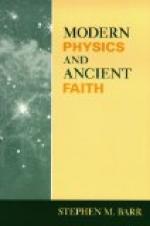Each atom of prakriti was the material universe in miniature. It held the potentialities of mind, life, and phenomena. In every aggregation of atoms, there were the four planes, each in touch through the Cosmic Mind, its manasa, with other atoms in the universe, with every other globe of whatever kind. “As above, so below,” was the secret Key-word. The unity of all the material universe in its prakriti, ether, prana and manasa, was the corner stone of this knowledge. The three planes above prakriti were called Astral, and in common speech there was the ordinary division into two planes, visible and invisible, or “Spirit,” as the invisible was called, and “Matter,” as the visible was called. Only in the hidden secret doctrine of physics, and in the open metaphysics which were a “stumbling block” and “foolishness” to those who had not the “inner light” of the physics, were the three divisions of the “astral” made known, and the true distinction between the spirit of the three higher planes and the matter of the four lower was kept out of the metaphysics, or only vaguely alluded to.
There is no “oriental science” because the oriental does not attach the same value to merely physical knowledge that we do. But that must not be understood to imply that there is no oriental physics. In all the matters that interest us now, as far as principles are concerned, the oriental knew all that we know. He knew it thousands of years ago, when our ancestors were sleeping with the cave bears.
“That is all the good it did him,” the scientist says. No. That is not true. It is perfectly true that the oriental, the Babylonian who carved on the Black Stone now in the British Museum the five moons of Jupiter, exposing himself to the derision of our astronomers prior to their own discovery of the fifth moon in 1898, did not care particularly whether there were four moons or five, and had no sale for any telescopes he might make, for no one else cared particularly. But it was not true that he did not care for any and all knowledge that would improve his spiritual condition by giving him correct ideas of the universe and of his own part in it. To him life was more than meat and the body more than raiment. He was more afraid of sin than of ignorance. We are more afraid of ignorance than of sin. He preferred to better men’s moral condition; we prefer to better their physical condition.
If one of the Sages of the East could be called up and put on the stand to be questioned, he would say, substantially:
“You are right in regard to your ether, and to prakriti being ether that has been dropped a great octave in vibration. Your physical atom is surrounded by a molecule of ether, this molecule containing many atoms of ether. The chording vibration does produce all physical phenomena.
“But where did the ether atom come from? How can you explain how and whence life comes, or what it is? This explains physical, but how do you explain vital phenomena?




